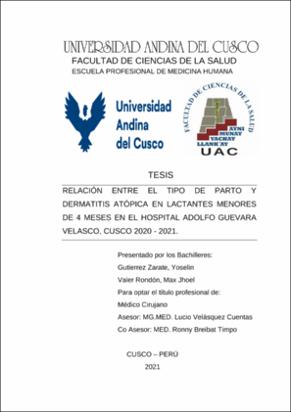| dc.contributor.advisor | Velásquez Cuentas, Lucio | |
| dc.contributor.advisor | Breibat Timpo, Ronny | |
| dc.contributor.author | Gutierrez Zarate, Yoselin | |
| dc.contributor.author | Valer Rondón, Max Jhoel | |
| dc.date.accessioned | 2021-08-27T18:32:27Z | |
| dc.date.available | 2021-08-27T18:32:27Z | |
| dc.date.issued | 2021-08-24 | |
| dc.identifier.uri | https://hdl.handle.net/20.500.12557/4050 | |
| dc.description.abstract | Antecedentes: La dermatitis atópica es una patología cutánea, crónica, multifactorial, de
tipo inflamatoria y pruriginosa que se presenta en la primera infancia, por lo general entre
los 3 y los 6 meses de edad. Es importante identificar la relación con el tipo de parto,
debido a la prevalencia de esta enfermedad y gran compromiso sobre la calidad de vida
de estos niños. Además, la relación entre dermatitis atópica y el tipo de parto no ha sido
muy estudiada.
Métodos: Estudio observacional, tipo analítico de cohortes, longitudinal y prospectivo.,
del hospital Adolfo Guevara Velasco Essalud – Cusco, 2020-2021. Se utilizaron los
criterios del Reino Unido para establecer el diagnóstico de dermatitis atópica. Además,
se midieron las variables: tipo de parto, sexo, peso al nacer, edad gestacional y escala
socioeconómica de Graffar. Se realizó el cálculo del Riesgo Relativo (RR) obteniendo
RR crudos y ajustados por las variables estadísticamente significativas.
Resultados: Se estudiaron 312 lactantes menores de 4 meses, 156 nacidos por cesárea y
156 nacidos por parto normal. Se obtuvo 29.5% de diagnosticados con dermatitis atópica
en la población estudiada. En el análisis estadístico se determinó una asociación positiva
entre tipo de parto y dermatitis atópica. El riesgo de desarrollar dermatitis atópica fue
significativamente mayor en los lactantes nacidos por cesárea en comparación con los
lactantes nacidos por parto normal en el modelo crudo [RR (IC del 95%): 2.83 (1,88 –
4,26), p<0.05], y en el modelo multivariado, ajustado por: sexo, escala socioeconómica
de Graffar, edad gestacional y peso al nacer [RR (IC del 95%): 1,65 (1,08 – 2,51), p<0.05]
continuó siendo significativo.
Conclusiones: Existe relación entre el tipo de parto y dermatitis atópica. Se observó
mayor riesgo de desarrollar dermatitis atópica en los lactantes nacidos por cesárea,
ajustando por variables como sexo, escala de Graffar, edad gestacional y peso al nacer. | es_PE |
| dc.description.abstract | Background: Atopic dermatitis is a chronic, multifactorial, inflammatory and pruritic
skin disease that occurs in early childhood, usually between 3 and 6 months of age. It is
important to identify the relationship with the type of delivery, due to the prevalence of
this disease and great compromise on the quality of life of these children. Furthermore,
the relationship between atopic dermatitis and the type of delivery has not been well
studied.
Methods: Observational study, analytical type of cohorts, longitudinal and prospective.
From the Adolfo Guevara Velasco Essalud hospital - Cusco, 2020-2021. The UK criteria
were used to establish the diagnosis of atopic dermatitis. In addition, variables were
measured: type of delivery, sex, birth weight, gestational age and Graffar's socioeconomic
scale. The Relative Risk (RR) calculation was performed, obtaining crude RRs adjusted
for statistically significant variables.
Results: 312 infants under 4 months of age were studied, 156 born by caesarean section
and 156 born by natural childbirth. 29.5% were diagnosed with atopic dermatitis in the
studied population. In the statistical analysis, a positive association was determined
between the type of delivery and atopic dermatitis. The risk of developing atopic
dermatitis was significantly higher in infants delivered by caesarean section compared to
infants delivered by natural childbirth in the crude model [RR (95% CI): 2.83 (1.88 -
4.26), p<0.05], and in the multivariate model, adjusted for: sex, Graffar's socioeconomic
scale, gestational age and birth weight [RR (95% CI): 1.65 (1.08 - 2.51), p<0.05]
continued to be significant.
Conclusions: There is a relationship between the type of delivery and atopic dermatitis.
A higher risk of developing atopic dermatitis was observed in infants born by caesarean
section, adjusting for variables such as sex, Graffar scale, gestational age, and birth
weight. | en_US |
| dc.format | application/pdf | es_PE |
| dc.language.iso | spa | es_PE |
| dc.publisher | Universidad Andina del Cusco | es_PE |
| dc.rights | info:eu-repo/semantics/openAccess | es_PE |
| dc.rights.uri | https://creativecommons.org/licenses/by-nc-nd/4.0/ | es_PE |
| dc.subject | Dermatitis atópica | es_PE |
| dc.subject | Cesárea | es_PE |
| dc.subject | Parto normal | es_PE |
| dc.subject | Lactante | es_PE |
| dc.title | Relación entre el tipo de parto y dermatitis atópica en lactantes menores de 4 meses en el Hospital Adolfo Guevara Velasco, Cusco 2020 - 2021 | es_PE |
| dc.type | info:eu-repo/semantics/bachelorThesis | es_PE |
| thesis.degree.name | Médico Cirujano | es_PE |
| thesis.degree.grantor | Universidad Andina del Cusco. Facultad de Ciencias de la Salud | es_PE |
| thesis.degree.discipline | Medicina Humana | es_PE |
| dc.publisher.country | PE | es_PE |
| dc.subject.ocde | https://purl.org/pe-repo/ocde/ford#3.02.02 | es_PE |
| renati.advisor.dni | 23834099 | |
| renati.advisor.dni | 41584936 | |
| renati.advisor.orcid | https://orcid.org/ 0000-0001-8996-9368 | es_PE |
| renati.author.dni | 74526817 | |
| renati.author.dni | 70310609 | |
| renati.discipline | 912016 | es_PE |
| renati.juror | Villamonte Calanche, Wilfredo Modesto | |
| renati.juror | Huamani Saldaña, Charles Augusto | |
| renati.juror | Condori Fernandez, Yaquelin | |
| renati.level | https://purl.org/pe-repo/renati/level#tituloProfesional | es_PE |
| renati.type | https://purl.org/pe-repo/renati/type#tesis | es_PE |


